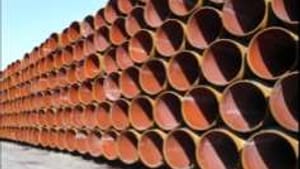Stay in the Loop
BSR publishes on a weekly schedule, with an email newsletter every Wednesday and Thursday morning. There’s no paywall, and subscribing is always free.
That cloud is expensive!
"Tubes': Andrew Blum travels the Internet

When Senator Ted Stevens of Alaska dismissed the Internet as a bunch of tubes, apostles of cyberspace bombarded him with ridicule. The prophets of the Internet Age have spent the last three decades convincing us that we now live in an ephemeral environment outside the tiresome restrictions of time, space and solid matter—a mystical Cloud, in the latest fashionable terminology.
But in fact the Internet is a globe-spanning physical structure. Our fascination with the symbols on our computer screens has obscured the fact that the Internet is an engineering marvel: an edifice that's just as awesome as the skyscrapers and space vehicles that excited previous generations.
In Tubes, Andrew Blum embarks on a personal globetrotting tour of the Internet and looks at the technological achievements that transmit numbers to market manipulators and baby pictures to doting grandparents.
One of the Internet's basic components, for example, is a chain of lasers that flash on and off ten billion times per second. The lasers flash their signals along fiber-optic cables that now run beside our highways and follow the undersea routes pioneered by telegraph and telephone cables.
Out of sight….
When the first transatlantic telegraph cable linked Ireland to Newfoundland in 1858, the feat was a major public event. In the last two decades, cable companies have added a dozen fiber-optic cables that come ashore at Long Island and New Jersey— and their effort has attracted less attention than the expansion of the New Jersey Turnpike.
The cables and the lasers are only part of the story. Blum also visits key facilities like the Internet exchanges, where smaller networks— like your Internet service provider— connect to the Internet. One of the sensory details that run through Blum's prose is the roar of the fans that cool the servers and hard drives.
Visually, the physical Internet isn't much of a tourist attraction. Its major facilities, Blum reports, look like self-storage warehouses. The Internet exchanges are basically large rooms packed with cages, a few feet wide, filled with anonymous boxes containing servers and routers.
Why New York?
Blum examines the connection between the Internet's geography and the physical and economic geography that has shaped the history of civilization. The cyberprophets may think we have liberated ourselves from those ancient realities, but they're wrong.
The oceanic cables follow routes that avoid undersea mountains and crowded shipping lanes. Two of the biggest Internet exchanges are located in Manhattan, just a few blocks apart, for one old, very practical reason: There are advantages in being located in a center of economic activity. Big data storage centers, housing 150,000 hard drives, cluster in a small area of Oregon because it possesses a cool climate (reducing energy demands) and the centers can tap the energy generated by the Columbia River power plants.
When people store their data in the Cloud, Blum notes, they are actually storing it in data centers. The biggest ones are rigorously engineered buildings that absorb 50 megawatts of power— enough electricity to light a small city. Data centers now consume 2% of the world's electricity output.
Under the city streets
The humans who create and maintain this system receive their share of attention. In New York, Blum hung out with the crews that descend into manholes at night and expand the fiber-optic network. In Portugal, he watched a technician strip the end of an undersea cable and fuse the fiber-optic strands with their counterparts in the cable that unites them with the land.
Blum's musings on the mystical relationship between the physical Internet and the mental Internet sometimes grow tedious. But most of his pages convey a lively picture of the technology and human effort that underlie our day-to-day encounters with this new factor in human affairs.
Tubes should be required reading for all the ultra-vocal Utopians who think everything on the Internet should be free. The Internet may look like a playground, but it's the product of awesome amounts of work, investment and demanding engineering.♦
To read a response, click here.
But in fact the Internet is a globe-spanning physical structure. Our fascination with the symbols on our computer screens has obscured the fact that the Internet is an engineering marvel: an edifice that's just as awesome as the skyscrapers and space vehicles that excited previous generations.
In Tubes, Andrew Blum embarks on a personal globetrotting tour of the Internet and looks at the technological achievements that transmit numbers to market manipulators and baby pictures to doting grandparents.
One of the Internet's basic components, for example, is a chain of lasers that flash on and off ten billion times per second. The lasers flash their signals along fiber-optic cables that now run beside our highways and follow the undersea routes pioneered by telegraph and telephone cables.
Out of sight….
When the first transatlantic telegraph cable linked Ireland to Newfoundland in 1858, the feat was a major public event. In the last two decades, cable companies have added a dozen fiber-optic cables that come ashore at Long Island and New Jersey— and their effort has attracted less attention than the expansion of the New Jersey Turnpike.
The cables and the lasers are only part of the story. Blum also visits key facilities like the Internet exchanges, where smaller networks— like your Internet service provider— connect to the Internet. One of the sensory details that run through Blum's prose is the roar of the fans that cool the servers and hard drives.
Visually, the physical Internet isn't much of a tourist attraction. Its major facilities, Blum reports, look like self-storage warehouses. The Internet exchanges are basically large rooms packed with cages, a few feet wide, filled with anonymous boxes containing servers and routers.
Why New York?
Blum examines the connection between the Internet's geography and the physical and economic geography that has shaped the history of civilization. The cyberprophets may think we have liberated ourselves from those ancient realities, but they're wrong.
The oceanic cables follow routes that avoid undersea mountains and crowded shipping lanes. Two of the biggest Internet exchanges are located in Manhattan, just a few blocks apart, for one old, very practical reason: There are advantages in being located in a center of economic activity. Big data storage centers, housing 150,000 hard drives, cluster in a small area of Oregon because it possesses a cool climate (reducing energy demands) and the centers can tap the energy generated by the Columbia River power plants.
When people store their data in the Cloud, Blum notes, they are actually storing it in data centers. The biggest ones are rigorously engineered buildings that absorb 50 megawatts of power— enough electricity to light a small city. Data centers now consume 2% of the world's electricity output.
Under the city streets
The humans who create and maintain this system receive their share of attention. In New York, Blum hung out with the crews that descend into manholes at night and expand the fiber-optic network. In Portugal, he watched a technician strip the end of an undersea cable and fuse the fiber-optic strands with their counterparts in the cable that unites them with the land.
Blum's musings on the mystical relationship between the physical Internet and the mental Internet sometimes grow tedious. But most of his pages convey a lively picture of the technology and human effort that underlie our day-to-day encounters with this new factor in human affairs.
Tubes should be required reading for all the ultra-vocal Utopians who think everything on the Internet should be free. The Internet may look like a playground, but it's the product of awesome amounts of work, investment and demanding engineering.♦
To read a response, click here.
What, When, Where
Tubes: A Journey to the Center of the Internet. By Andrew Blum. HarperCollins, 2012. 294 Pages; $26.99. www.amazon.com.
Sign up for our newsletter
All of the week's new articles, all in one place. Sign up for the free weekly BSR newsletters, and don't miss a conversation.

 Tom Purdom
Tom Purdom